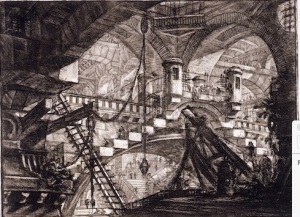“When all the world was a palimpsest, it was a perfect palindrome.”–The Slow Regard of Silent Things
In Molière’s classic play Le Bourgeois Gentilhomme, the title character discovers proudly that he is able to speak prose. When I think of how many of my students have had difficulty figuring out the difference between prose and verse, I consider the bourgeois gentleman unusually erudite to learn the distinction between them. That difference, however, founders on a genre that itself comes largely from France: the prose poem. It was pioneered in Charles Baudelaire’s second great work, Le Spleen de Paris, and those English-language authors who shaped the sonic effects of their prose in imitation of verse (e.g., James Joyce) had come under French influence.
With Baudelaire, the mixing of prose and poetry arises from a desire to push the L5 materialist obsessions with things so far that it becomes an L6 opening to the unconscious, appropriate to poetry. At least by the end of the 19th century, the growth in L5 (capitalist and scientific materialism) meant that a host of poets were trying to bring poetry closer to the language of commerce and technology: prose. Since then such avant-garde French authors as Francis Ponge and Alain Robbe-Grillet wrote a poetic prose consisting almost exclusively of things described in great detail. The style comes from that particularly Parisian custom of being a “flâneur” (mall lounger), gazing with rapt attention on fashionable objects.
What is bringing all this to my mind is the release today of Patrick Rothfuss’s The Slow Regard of Silent Things, a novela-long evocation of an isolated, charmingly deranged young woman’s animistic relationship with things. He begins with a warning to his fans that this is not quite like his best-selling fantasy but it certainly has predecessors, e.g., the Benjy section of William Faulkner’s The Sound and the Fury. Rothfuss’s novela, however, is in a couple of ways new to prose poetry. First, despite the warning, it is being marketed as a spinoff of popular fantasy, not as European or avant-garde. Perhaps, that means a solitary character’s ramblings told in alliterative, sometimes rhyming prose is no longer that much ahead of the American mainstream. Second, like the rest of the series, it is finding a popular style for the Daoist notion that the world is only perceived and dealt with well if one acts according to what is proper to the Dao without trying to conform objects to one’s desire. Like the avant-garde writings of Franz Kafka (also much tinged with Daoism), Rothfuss’s novela asks the question of whether such a selfless empathy for things is insane or insightful. Because Rothfuss’s story is largely set in an underground labyrinth, I am particularly reminded of Kafka’s “The Burrow” (Der Bau) about an animal or deranged person in a subterranean lair. Both describe the very human tendency to mingle the objective and subjective in a setting symbolic of the unconscious–as, of course, prose poetry does. Since I have just been perusing Anam Thubten’s No Self, No Problem, I am struck by how closely Rothfuss’s character resembles the selfless being merged with environment that Thubten recommends becoming. But as with the Piranesi picture I use to head this post, such surreal entries into the unconscious have seemed to many only appropriate for the asylum or prison.

